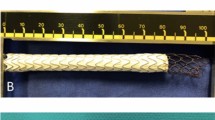Abstract
Purpose
Iliocaval obstruction is a substantial contributor to chronic venous insufficiency and is increasingly being treated endovascularly with angioplasty and stent placement. Utilization of an appropriate stent for treatment is pivotal; however, until today, mechanical properties of venous stents remain unknown.
Materials and Methods
We analyzed the radial resistive force, the chronic outward force, as well as the crush resistance of seven stent models [Zilver Vena (Cook, Bjaeverskov, Denmark), Sinus Venous, Sinus Obliquus and Sinus XL Flex (Optimed, Ettlingen, Germany), Vici (Veniti; St. Louis, USA), Wallstent (Boston Scientific, Marlborough, USA), and Venovo (Bard, Tempe, USA)] in vitro using a radial force testing machine (RX-650, Machine Solutions Inc., Flagstaff, AZ, USA) and a hardness testing machine (zwickiLine, Zwick Roell, Ulm, Germany).
Results
The Sinus Obliquus revealed the highest radial resistive force (19.41 N/cm) and the highest chronic outward force at 50 and 30% nominal diameter (7.93 N/cm at 50%, 16.97 N/cm at 30%) while the Venovo revealed the highest chronic outward force at 90 and 80% nominal diameter (4.83 N/cm at 90%, 5.37 N/cm at 80%). The radial resistive force and the chronic outward force of the Wallstent greatly depended on whether the stent ends were fixated. The Wallstent revealed the highest crush resistance at nominal diameters of 90% (0.46 N/cm) to 60% (1.16 N/cm). The Sinus Obliquus revealed the highest crush resistance at a nominal diameter of 50% (1.41 N/cm).
Conclusion
Venous stents greatly differ regarding their mechanical properties. These results should be considered when choosing an appropriate stent for the treatment of venous obstruction.






Similar content being viewed by others
References
Oderich GS, Treiman GS, Schneider P, Bhirangi K. Stent placement for treatment of central and peripheral venous obstruction: a long-term multi-institutional experience. J Vasc Surg. 2000;32(4):760–9.
Funaki B, Szymski GX, Leef JA, et al. Treatment of venous outflow stenoses in thigh grafts with Wallstents. AJR Am J Roentgenol. 1999;172(6):1591–6.
Sista AK, Vedantham S, Kaufman JA, Madoff DC. Endovascular interventions for acute and chronic lower extremity deep venous disease: state of the art. Radiology. 2015;276(1):31–53.
Raju S, Tackett P Jr, Neglen P. Reinterventions for nonocclusive iliofemoral venous stent malfunctions. J Vasc Surg. 2009;49(2):511–8.
Raju S, Owen S Jr, Neglen P. The clinical impact of iliac venous stents in the management of chronic venous insufficiency. J Vasc Surg. 2002;35(1):8–15.
Neglen P. Chronic venous obstruction: diagnostic considerations and therapeutic role of percutaneous iliac stenting. Vascular. 2007;15(5):273–80.
Neglen P, Hollis KC, Olivier J, Raju S. Stenting of the venous outflow in chronic venous disease: long-term stent-related outcome, clinical, and hemodynamic result. J Vasc Surg. 2007;46(5):979–90.
Neglen P, Thrasher TL, Raju S. Venous outflow obstruction: an underestimated contributor to chronic venous disease. J Vasc Surg. 2003;38(5):879–85.
Raju S, Neglen P. Laser, “closure”, stents and other new technology in the treatment of venous disease. J Miss State Med Assoc. 2004;45(10):290–7.
Raju S, Neglen P. High prevalence of nonthrombotic iliac vein lesions in chronic venous disease: a permissive role in pathogenicity. J Vasc Surg. 2006;44(1):136–43 (discussion 44).
Maleux G, Vertenten B, Laenen A, et al. Palliative endovascular treatment of cancer-related iliocaval obstructive disease: technical and clinical outcomes. Acta Radiol. 2016;57(4):451–6.
Devcic Z, Techasith T, Banerjee A, Rosenberg JK, Sze DY. Technical and Anatomic Factors Influencing the Success of Inferior Vena Caval Stent Placement for Malignant Obstruction. J Vasc Interv Radiol. 2016;27(9):1350–60.
Kim DB, Choi H, Joo SM, et al. A comparative reliability and performance study of different stent designs in terms of mechanical properties: foreshortening, recoil, radial force, and flexibility. Artif Organs. 2013;37(4):368–79.
Neglen P, Raju S. Balloon dilation and stenting of chronic iliac vein obstruction: technical aspects and early clinical outcome. J Endovasc Ther. 2000;7(2):79–91.
Lamont JP, Pearl GJ, Patetsios P, et al. Prospective evaluation of endoluminal venous stents in the treatment of the May-Thurner syndrome. Ann Vasc Surg. 2002;16(1):61–4.
Palmaz JC. Intravascular stents: tissue-stent interactions and design considerations. AJR Am J Roentgenol. 1993;160(3):613–8.
O’Sullivan GJ, Waldron D, Mannion E, Keane M, Donnellan PP. Thrombolysis and iliofemoral vein stent placement in cancer patients with lower extremity swelling attributed to lymphedema. J Vasc Interv Radiol. 2015;26(1):39–45.
de Wolf MA, de Graaf R, Kurstjens RL, Penninx S, Jalaie H, Wittens CH. short-term clinical experience with a dedicated venous nitinol stent: initial results with the sinus-venous stent. Eur J Vasc Endovasc Surg. 2015;50(4):518–26.
O’Sullivan GJ, Sheehan J, Lohan D, McCann-Brown JA. Iliofemoral venous stenting extending into the femoral region: initial clinical experience with the purpose-designed Zilver Vena stent. J Cardiovasc Surg. 2013;54(2):255–61.
Acknowledgements
We thank AB Medica, Bard, Boston Scientific, Cook, and Optimed for donating the stents used in this study.
Author information
Authors and Affiliations
Corresponding author
Ethics declarations
Conflict of interest
None of the authors have conflicts of interests.
Ethical Approval
This article does not contain any studies with human participants or animals performed by any of the authors. For this type of study, formal consent is not required.
Rights and permissions
About this article
Cite this article
Dabir, D., Feisst, A., Thomas, D. et al. Physical Properties of Venous Stents: An Experimental Comparison. Cardiovasc Intervent Radiol 41, 942–950 (2018). https://doi.org/10.1007/s00270-018-1916-1
Received:
Accepted:
Published:
Issue Date:
DOI: https://doi.org/10.1007/s00270-018-1916-1




